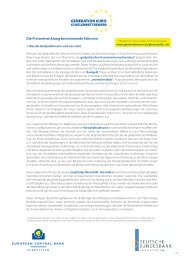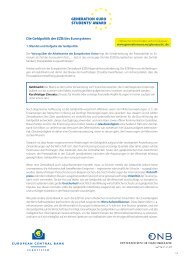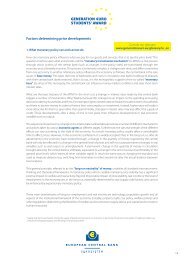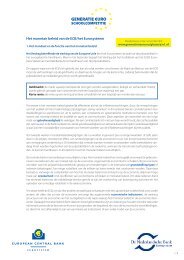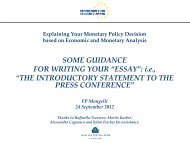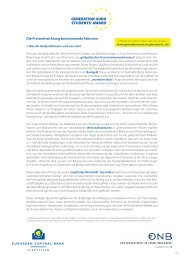Examples of economic analysis - the Generation ?uro Students' Award
Examples of economic analysis - the Generation ?uro Students' Award
Examples of economic analysis - the Generation ?uro Students' Award
Create successful ePaper yourself
Turn your PDF publications into a flip-book with our unique Google optimized e-Paper software.
Explaining Your Monetary Policy Decision<br />
based on Economic and Monetary Analysis<br />
SOME GUIDANCE<br />
FOR WRITING YOUR ESSAY<br />
FP Mongelli<br />
20 September 2011
What you have to do<br />
• You are in charge <strong>of</strong> price stability over <strong>the</strong> medium-term.<br />
• Your objective is to to write an essay explaining <strong>the</strong> reasons for your interest rate decision<br />
by referring to <strong>the</strong> underlying <strong>economic</strong> and monetary <strong>analysis</strong>.<br />
• You also need to explain your inflation outlook as well as <strong>the</strong> various risk factors.<br />
1 st , what is <strong>the</strong> medium term?<br />
• It is a timeframe between <strong>the</strong> short-term – i.e., a period <strong>of</strong> one or at most two years - and <strong>the</strong><br />
long term which can last several more years – say <strong>the</strong> completion <strong>of</strong> a business cycle: not to<br />
paraphrase JM Keynes (that in <strong>the</strong> LT we all passed away).<br />
• Thus for all practical purposes your time-frame is <strong>of</strong> about 2-3-4 years.<br />
2 nd, your mandate is to maintain inflation close but below 2% over <strong>the</strong> medium term:<br />
– This is your price stability objective a year-on-year increase <strong>of</strong> HICPs < 2% over MT<br />
– If <strong>the</strong>re is no incompatibility, <strong>the</strong>n you can consider also o<strong>the</strong>r objectives that are ancillary, like<br />
<strong>economic</strong> growth and employment<br />
– but let’s simplify this essay and only focus on price stability (that is difficult enough)<br />
3 rd , why does <strong>the</strong> choice <strong>of</strong> timeframe in which you need to achieve your objective greatly matter?<br />
• Because every month, or quarter, price dynamics are affected by a great variety <strong>of</strong> shocks, or<br />
news, or self-reverting events (like a strike, some temporary disruption, or o<strong>the</strong>r short lived<br />
blips)
What you have to do…<br />
– These are <strong>of</strong>ten called “noise” by statisticians and economists<br />
– Instead, you need to correctly interpret underlying price signals that emerge from <strong>the</strong> very<br />
structure <strong>of</strong> <strong>the</strong> <strong>economic</strong>, monetary and financial systems<br />
4 th , what is your geographic domain?<br />
– It is <strong>the</strong> e<strong>uro</strong> area as a whole: i.e., considering it as a single geographic entity<br />
– Some comments on <strong>the</strong> concept <strong>of</strong> <strong>economic</strong> and financial integration.<br />
– At <strong>the</strong> same time <strong>the</strong> <strong>analysis</strong> <strong>of</strong> heterogeneity and/or persistent imbalances has acquired<br />
greater prominence in recent years (but is not going to be that relevant for your Essay)<br />
5 th, now imagine that you were <strong>the</strong> President <strong>of</strong> <strong>the</strong> ECB and thus <strong>the</strong> Chair <strong>of</strong> <strong>the</strong> Governing<br />
Council …<br />
– you would be commanding one <strong>of</strong> <strong>the</strong> greatest pr<strong>of</strong>essional and also intellectual armies in <strong>the</strong><br />
world<br />
– basically all types <strong>of</strong> data, statistics, information, facts about <strong>the</strong> e<strong>uro</strong> area economy would be<br />
available to you as well as all o<strong>the</strong>r Governing Council members<br />
– moreover, you would have at your disposal <strong>the</strong> best <strong>economic</strong> and monetary <strong>analysis</strong> possible<br />
for <strong>the</strong> e<strong>uro</strong> area.<br />
– it is also important to note that this wealth <strong>of</strong> data and information is also available to all<br />
beyond <strong>the</strong> E<strong>uro</strong>system, i.e., it is “publicly available information”
What you have to do…<br />
6 th , Imagine that it’s <strong>the</strong> first Thursday <strong>of</strong> <strong>the</strong> month: <strong>the</strong> day <strong>of</strong> <strong>the</strong> “voting” Governing Council.<br />
– Imagine that you have just met with your peers, <strong>the</strong> members <strong>of</strong> <strong>the</strong> Governing Council, and<br />
conducted <strong>the</strong> <strong>economic</strong> and monetary <strong>analysis</strong> plus <strong>the</strong> cross checking<br />
– You need now to explain your decision to a vast public that ranges from skilled “ECB<br />
watchers”, o<strong>the</strong>r policy makers, <strong>the</strong> media, and <strong>the</strong> interested public at large.<br />
– Explain in <strong>the</strong> Essay that <strong>the</strong> monetary policy decision that you have taken concerning <strong>the</strong><br />
appropriate interest rate level - is that <strong>of</strong> <strong>the</strong> Governing Council in its collegiality<br />
– Moreover, as soon as you have finished reading out <strong>the</strong> essay, questions from <strong>the</strong> media that<br />
is sitting in <strong>the</strong> Press Conference room will start flocking (<strong>the</strong>re are about 2-300 journalists)<br />
– Questions can range from something you said in your “essay”, or anything that you have<br />
publicly discussed over recent days/weeks, or anything said by some o<strong>the</strong>r Board/Governing<br />
Council members, or anything even indirectly related to <strong>the</strong> decision(s) you took.<br />
Thus be prepared to explain anything you write in <strong>the</strong> essay.<br />
7 th , how can you organise both your <strong>analysis</strong>, Governing Council discussion, deliberation and<br />
explanation to <strong>the</strong> above vast public? Is <strong>the</strong>re an organising device?<br />
– Yes, it is shown in <strong>the</strong> picture in <strong>the</strong> next slide: we call it a Monetary Policy Strategy.<br />
– It shows what is frequently called as “two-pillar <strong>analysis</strong>” plus <strong>the</strong> cross checking.
What you have to do…<br />
7 th , now you have to explain your decision in an Essay <strong>of</strong> up to 2,000 words (roughly two-three A4<br />
pages). You have to be concise and convincing. Thus remember that you have to:<br />
– Explain also <strong>the</strong> pros and cons <strong>of</strong> your decisions,<br />
– Lay out <strong>the</strong> various risks you see (both bad risks and positive risks), and,<br />
– looking ahead, also present some possible scenarios<br />
8 th , remember that your goal is to explain principally what has changed since your last Introductory<br />
Statement/Essay.<br />
It is about interpreting new information and whe<strong>the</strong>r it changes your broad picture and <strong>the</strong> various<br />
risks to price stability and scenarios. Economists call this a “repeated game”<br />
– In fact, you meet with your peers to discuss interest rates at least once a month (also <strong>the</strong>re are<br />
teleconferences and o<strong>the</strong>r Governing Council meetings).<br />
– There is an underlying consensus that builds up over time and new evidence confirms it or<br />
requires some adaptations.<br />
– Thus your focus should be <strong>the</strong> new data/information or developments that have occurred over<br />
recent weeks and that require changes in your baseline scenario.<br />
9 th , unless <strong>the</strong>re is a systemic crisis – like <strong>the</strong> ongoing financial crisis - which is a game changer…<br />
– Then you need to assess <strong>the</strong> severity <strong>of</strong> <strong>the</strong> events unfolding<br />
– Most backward data and information that you have collected loose partly in significance
…and why is it difficult?<br />
The exercise that you are about to engage in, is rendered more challenging by <strong>the</strong> following<br />
difficulties (but <strong>the</strong>re are o<strong>the</strong>rs):<br />
1 st , <strong>the</strong> most complex <strong>of</strong> all difficulties is that you will be acting “in real time”<br />
• i.e., <strong>the</strong> data you are using has some lag with respect to what is happening now.<br />
• You don’t know precisely <strong>the</strong> current state <strong>of</strong> <strong>the</strong> economy right now.<br />
• an analogy would be that you know your body temperature <strong>of</strong> last week (and not today) and<br />
yet you need to decide whe<strong>the</strong>r you stay home and take medicines (and/or go to <strong>the</strong> doctor)<br />
• You may have to undertake some guessing work and some projecting/forecasting is involved.<br />
• You will also need to use some coincidental and leading indicators.<br />
2 nd , <strong>the</strong>re is also what we call “model uncertainty”<br />
• i.e. our analytical tools only provide an interpretation <strong>of</strong> reality…<br />
… while <strong>the</strong> economy may be changing over time<br />
• An increase in oil prices today may be reverted soon or be <strong>the</strong> start <strong>of</strong> a trend<br />
• Similarly if you misjudge <strong>the</strong> pace <strong>of</strong> innovation, you may unduly keep monetary policy too<br />
tight.
…and why is it difficult?<br />
3 rd , <strong>the</strong>re is also <strong>the</strong> policy debate, interaction among policy makers and voting outcome<br />
– Most times Governing Council decisions are by consensus and for a long time this has<br />
been <strong>the</strong> main outcome<br />
– More recently some dissent has emerged: some public and some latent<br />
– For <strong>the</strong> purpose <strong>of</strong> your essay we only look at “consensual decisions”: i.e., your team<br />
agrees on one decision which it <strong>the</strong>n explains.<br />
The rest <strong>of</strong> this presentation is about some key elements for <strong>the</strong> Essay
The Introductory Statement (IS) preceding <strong>the</strong> ECB’s<br />
Press Conferences is a “model” essay …<br />
• See http://www.ecb.e<strong>uro</strong>pa.eu/press/pressconf/2011/html/index.en.html<br />
• Introductory paragraph<br />
• Monetary policy decisions<br />
• Key monetary policy messages / intentions / signals<br />
• Economic <strong>analysis</strong><br />
• Growth and employment developments<br />
• Price developments<br />
• Once a quarter, summary <strong>of</strong> staff projections<br />
• Monetary <strong>analysis</strong><br />
• Money growth<br />
• Credit growth<br />
• Cross-checking / summing-up
… but <strong>the</strong> IS is also a highly policy-intense and<br />
politically dense statement<br />
• From time to time <strong>the</strong> IS also contains fiscal and structural policy messages<br />
• Yet, <strong>the</strong> desire <strong>of</strong> <strong>the</strong> organisers <strong>of</strong> <strong>the</strong> <strong>Generation</strong> €<strong>uro</strong> Students <strong>Award</strong> is not to receive a<br />
“copy and paste” with some editing exercise from <strong>the</strong> IS.<br />
• This happened to some extent in <strong>the</strong> pilot exercise.<br />
• Hence, while it is OK to seek some inspirations from <strong>the</strong> IS and also some ECB Monthly<br />
Bulletin articles or text, you should attempt to provide your own thoughts<br />
• In <strong>the</strong> rest <strong>of</strong> this presentation we show some examples <strong>of</strong> recent time series that have a<br />
bearing on your essay and present <strong>the</strong> main features <strong>of</strong> <strong>the</strong> <strong>economic</strong> and monetary <strong>analysis</strong>
Here are key interest rate facts:<br />
what decision do you recommend next?<br />
• It currently stands at 1.50%<br />
• It is reviewed monthly but only changed occasionally (31 changes since 1999)<br />
• It is changed in discrete steps <strong>of</strong> 25, 50 and sometimes 75 basis points<br />
5.0<br />
4.5<br />
4.0<br />
3.5<br />
3.0<br />
2.5<br />
2.0<br />
1.5<br />
1.0<br />
0.5<br />
0.0<br />
1999 2000 2001 2002 2003 2004 2005 2006 2007 2008 2009 2010 2011
3.0<br />
2.8<br />
2.6<br />
2.4<br />
2.2<br />
2.0<br />
1.8<br />
Example: Long-term inflation expectations from surveys<br />
and break-even inflation rates (role <strong>of</strong> credibility)<br />
5-year forward 5 years ahead BEIR<br />
5-year I/L swap rate 5 years ahead<br />
ECB Survey <strong>of</strong> Pr<strong>of</strong>essional Forecasters (long-term)<br />
3.0<br />
2.8<br />
2.6<br />
2.4<br />
2.2<br />
2.0<br />
1.8<br />
1.6<br />
1.6<br />
Jan-08<br />
Apr-08<br />
Jul-08<br />
Oct-08<br />
Jan-09<br />
Apr-09<br />
Jul-09<br />
Oct-09<br />
Jan-10<br />
Apr-10<br />
Jul-10<br />
Oct-10<br />
Jan-11<br />
Apr-11<br />
Jul-11<br />
Sources: ECB and Reuters.<br />
Latest observation: BEIR and I/L swaps – 8 September 2011 and 2011Q3 SPF – July 2011.
THE “TWO-PILLAR APPROACH”<br />
The two Pillar Approach shown in <strong>the</strong> previous picture consists <strong>of</strong> two complementary<br />
perspectives:<br />
– The <strong>economic</strong> <strong>analysis</strong> (EA) that is aimed at assessing short to medium-term risks to<br />
price stability. Its focus is on real activity and financial conditions in <strong>the</strong> economy.<br />
– The monetary <strong>analysis</strong> (MA) focuses on a longer-term horizon, exploiting <strong>the</strong> long-run<br />
link between money and prices.<br />
MA also serves as a means <strong>of</strong> cross-checking, from a medium to long-term<br />
perspective, <strong>the</strong> short to medium-term indications from <strong>the</strong> <strong>economic</strong> <strong>analysis</strong>.<br />
• This dual approach secures robustness and works as an “insurance mechanism”<br />
• It allows a close mapping between <strong>the</strong> Monetary Policy Strategy and <strong>the</strong> Communication<br />
policy.
ECONOMIC ANALYSIS (I)<br />
• The Economic Analysis takes account <strong>of</strong> <strong>the</strong> fact that price developments over <strong>the</strong> short and<br />
medium term are influenced largely by <strong>the</strong> interplay <strong>of</strong> supply and demand in <strong>the</strong> goods,<br />
services and factor markets (see next picture)<br />
• To conduct <strong>the</strong> <strong>economic</strong> <strong>analysis</strong>, <strong>the</strong> ECB regularly reviews amongst o<strong>the</strong>rs various<br />
hardcore macro indicators such as:<br />
– developments in overall output,<br />
– demand and labour market conditions,<br />
– a broad range <strong>of</strong> price and cost indicators,<br />
– fiscal policy, and<br />
– <strong>the</strong> balance <strong>of</strong> payments for <strong>the</strong> e<strong>uro</strong> area.
ECONOMIC ANALYSIS (II)<br />
• Asset prices and financial yields<br />
– Financial variables are analysed to derive information about <strong>the</strong> expectations <strong>of</strong> financial<br />
markets, including expected future price developments.<br />
– Using a variety <strong>of</strong> techniques, financial prices permit to “extract” <strong>the</strong> markets’ implicit<br />
expectations about future developments.<br />
• Macro<strong>economic</strong> projections<br />
– Projections, a synonym <strong>of</strong> forecasts, are produced under <strong>the</strong> responsibility <strong>of</strong> <strong>the</strong> ECB<br />
and <strong>the</strong> E<strong>uro</strong>system staff using analytical tools and empirical models.<br />
– The projections help to structure and syn<strong>the</strong>sise a large amount <strong>of</strong> <strong>economic</strong> data. They<br />
ensure consistency across different sources <strong>of</strong> <strong>economic</strong> evidence.<br />
– Permit to sharpen <strong>the</strong> assessment <strong>of</strong> <strong>economic</strong> prospects and <strong>the</strong> short to medium-term<br />
fluctuations <strong>of</strong> inflation around its trend.
<strong>Examples</strong> <strong>of</strong> <strong>economic</strong> <strong>analysis</strong><br />
• Changes in inflation (year-on-year)<br />
5<br />
4<br />
3<br />
2<br />
1<br />
0<br />
-1<br />
Latest observation: August 2011<br />
1999 2000 2001 2002 2003 2004 2005 2006 2007 2008 2009 2010 2011
<strong>Examples</strong> <strong>of</strong> <strong>economic</strong> <strong>analysis</strong><br />
• Changes in real GDP (percentage changes)<br />
5.0<br />
4.0<br />
3.0<br />
2.0<br />
1.0<br />
0.0<br />
-1.0<br />
-2.0<br />
-3.0<br />
-4.0<br />
-5.0<br />
annual percentage changes (LHS)<br />
quarter on quarter percentage changes (RHS)<br />
2.5<br />
2.0<br />
1.5<br />
1.0<br />
0.5<br />
0.0<br />
-0.5<br />
-1.0<br />
-1.5<br />
-2.0<br />
-2.5<br />
-6.0<br />
1999 2000 2001 2002 2003 2004 2005 2006 2007 2008 2009 2010 2011<br />
-3.0<br />
Latest observation: 2011Q2
<strong>Examples</strong> <strong>of</strong> <strong>economic</strong> <strong>analysis</strong><br />
• Changes in unemployment<br />
5.0<br />
10.5<br />
4.0<br />
unemployment rate (RHS)<br />
10.0<br />
3.0<br />
9.5<br />
2.0<br />
9.0<br />
1.0<br />
8.5<br />
0.0<br />
8.0<br />
-1.0<br />
annual change in millions (LHS)<br />
-2.0<br />
1999 2000 2001 2002 2003 2004 2005 2006 2007 2008 2009 2010 2011<br />
7.5<br />
7.0<br />
Latest observation: July 2011
<strong>Examples</strong> <strong>of</strong> <strong>economic</strong> <strong>analysis</strong><br />
• Staff projections<br />
• Latest figures released in early September 2011<br />
• Next release at <strong>the</strong> December 2011 Press Conference (thus every 3 months)<br />
• Important to check how <strong>the</strong> numbers have changed compared with <strong>the</strong> last release<br />
• How do <strong>the</strong>y compare with <strong>the</strong> definition <strong>of</strong> price stability?<br />
2010 2011 2012<br />
HICP-September 2011 1.6 2.5-2.7 1.2-2.2<br />
HICP-June 2011 1.6 2.5-2.7 1.1-2.3<br />
GDP-September 2011 1.7 1.4-1.8 0.4-2.2<br />
GDP-June 2011 1.7 1.5-2.3 0.6-2.8
A remark: what type <strong>of</strong> data should you look at?<br />
• You will quickly notice an enormous number <strong>of</strong> data series and charts like <strong>the</strong> one below<br />
• Look in fact at <strong>the</strong> relevance <strong>of</strong> seasonality: e.g., in e<strong>uro</strong> area industrial production<br />
• By necessity, <strong>the</strong> data we look at are not “pure” but <strong>the</strong>y are filtered somehow: here is one useful<br />
example, while ano<strong>the</strong>r example <strong>of</strong> filtering comes along with <strong>the</strong> monetary <strong>analysis</strong>.<br />
120.0<br />
110.0<br />
100.0<br />
90.0<br />
80.0<br />
70.0<br />
60.0<br />
1999 2000 2001 2002 2003 2004 2005 2006 2007 2008 2009 2010
Monetary Analysis<br />
The ECB is almost unique among <strong>the</strong> leading central banks in assigning a high importance to<br />
monetary aggregates.<br />
Why does <strong>the</strong> ECB do that?<br />
– Reason 1: in <strong>the</strong> medium to long run monetary growth and inflation are closely related.<br />
– Reason 2: <strong>the</strong> <strong>analysis</strong> <strong>of</strong> credit and liquidity conditions enables <strong>the</strong> ECB to see beyond<br />
<strong>the</strong> transient impact <strong>of</strong> <strong>the</strong> various shocks.<br />
• Which monetary aggregates?<br />
– M1 has been defined as currency in circulation plus overnight deposits.<br />
– M2 comprises M1 plus deposits with an agreed maturity <strong>of</strong> up to and including two years<br />
and deposits redeemable at notice <strong>of</strong> up to and including three months.<br />
– M3 comprises M2 plus repurchase agreements, money market fund shares and units as<br />
well as debt securities with a maturity <strong>of</strong> up to and including two years.
Monetary Analysis<br />
• Beyond assessing <strong>the</strong> growth <strong>of</strong> <strong>the</strong> broad monetary aggregate M3, diverse o<strong>the</strong>r monetary<br />
and financial variables are also informative, including:<br />
– developments in <strong>the</strong> components <strong>of</strong> M3 (e.g. cash in circulation and time deposits) as<br />
<strong>the</strong>y can <strong>of</strong>fer an insight into <strong>the</strong> overall changes in M3; and<br />
– narrower aggregates such as M1 may contain some information about real activity.<br />
• Similarly, changes in credit extended to <strong>the</strong> private sector can also be informative about<br />
financial conditions and, through <strong>the</strong> monetary financial institutions (MFI) balance sheet, can<br />
provide additional information about money.<br />
• Moreover, <strong>the</strong> <strong>analysis</strong> <strong>of</strong> money and credit may provide early information on developing<br />
financial instability. This is <strong>of</strong> relevance for SMP because over time <strong>the</strong> emergence <strong>of</strong><br />
financial imbalances or asset price bubbles could have a destabilising effect on activity and,<br />
ultimately, prices.
A remark: what type <strong>of</strong> data should you look at? Monetary Analysis,<br />
annualised quarter-on-quarter changes, deviations from mean<br />
8<br />
8<br />
6<br />
6<br />
6<br />
6<br />
6<br />
6<br />
4<br />
4<br />
3<br />
3<br />
3<br />
3<br />
3<br />
3<br />
0<br />
0<br />
0<br />
0<br />
0<br />
0<br />
0<br />
0<br />
-4<br />
-4<br />
-3<br />
-3<br />
-3<br />
-3<br />
-3<br />
-3<br />
-8<br />
-8<br />
1974 1981 1988 1995 2002 2009<br />
M3 =<br />
-6<br />
-6<br />
-6<br />
-6<br />
1974 1981 1988 1995 2002 2009<br />
1974 1981 1988 1995 2002 2009<br />
Low<br />
Business cycle<br />
frequency<br />
+<br />
frequency<br />
component<br />
component<br />
-6<br />
1974 1981 1988 1995 2002 2009<br />
High<br />
+<br />
frequency<br />
component<br />
-6<br />
e.g. inflation<br />
(expectations)<br />
e.g. <strong>economic</strong><br />
activity<br />
e.g. bank<br />
behaviour
MONEY GROWTH AND INFLATION IN THE EURO AREA<br />
High frequency<br />
Low frequency<br />
9<br />
9<br />
8<br />
8<br />
6<br />
3<br />
M3<br />
6<br />
3<br />
4<br />
4<br />
0<br />
0<br />
0<br />
M3<br />
0<br />
-3<br />
-6<br />
HICP<br />
-3<br />
-6<br />
-4<br />
HICP<br />
-4<br />
-9<br />
1974 1982 1990 1998 2006<br />
-9<br />
-8<br />
1974 1982 1990 1998 2006<br />
-8<br />
Source: ECB. Chart shows annual percentage changes as deviations from <strong>the</strong> mean.
Example <strong>of</strong> monetary <strong>analysis</strong><br />
• Changes in M3 (annual percentage changes, adjusted for seasonal and calendar<br />
effects)<br />
14<br />
12<br />
10<br />
8<br />
6<br />
4<br />
2<br />
0<br />
-2<br />
1999 2000 2001 2002 2003 2004 2005 2006 2007 2008 2009 2010 2011<br />
Latest observation: September 2011
Example <strong>of</strong> monetary <strong>analysis</strong><br />
• Loans to households and non-financial corporations (annual percentage changes;<br />
seasonally adjusted)<br />
16<br />
14<br />
12<br />
10<br />
8<br />
6<br />
4<br />
2<br />
0<br />
-2<br />
-4<br />
non-financial corporations<br />
households<br />
1999 2000 2001 2002 2003 2004 2005 2006 2007 2008 2009 2010 2011<br />
Latest observation: 2011 Q2
Cross-checking<br />
• Are <strong>the</strong> messages from <strong>the</strong> <strong>economic</strong> <strong>analysis</strong> and <strong>the</strong><br />
monetary <strong>analysis</strong> consistent?<br />
• October 2010: “A cross-check <strong>of</strong> <strong>the</strong> outcome <strong>of</strong> our<br />
<strong>economic</strong> <strong>analysis</strong> with that <strong>of</strong> <strong>the</strong> monetary <strong>analysis</strong><br />
confirms that inflationary pressures over <strong>the</strong> medium<br />
term remain contained, as suggested by weak money<br />
and credit growth.”
The importance <strong>of</strong> expectations for <strong>the</strong> economy<br />
• Many points in <strong>the</strong> Introductory Statement refer to expectations and<br />
are forward-looking in nature, e.g.:<br />
• “Statistical releases and survey evidence generally confirm our<br />
expectation <strong>of</strong> a moderation in <strong>the</strong> second half <strong>of</strong> this year in <strong>the</strong><br />
e<strong>uro</strong> area and elsewhere.”<br />
• “The global recovery is expected to go on.”<br />
• This is due to <strong>the</strong> fact that monetary policy takes quite some time to<br />
have an effect on <strong>the</strong> economy (via <strong>the</strong> transmission mechanism).
The importance <strong>of</strong> expectations …<br />
• Of course, we cannot be certain about <strong>the</strong> future<br />
• “The risks to this <strong>economic</strong> outlook are slightly tilted to <strong>the</strong> downside…”<br />
• “… with uncertainty still prevailing”<br />
• “Risks to <strong>the</strong> outlook for price developments are slightly tilted to <strong>the</strong> upside”<br />
probability /<br />
likelihood<br />
less uncertainty<br />
probability /<br />
likelihood<br />
more uncertainty<br />
downside<br />
risks<br />
Modal<br />
view<br />
inflation<br />
Modal<br />
view<br />
inflation
Example: Distribution <strong>of</strong> E<strong>uro</strong> Area Barometer<br />
2010 HICP Forecasts<br />
2.5<br />
Value <strong>of</strong> density function<br />
2<br />
1.5<br />
1<br />
Jun09, Mar10<br />
1.1<br />
Sep09,<br />
Dec09<br />
1.2<br />
Apr10<br />
1.2<br />
Averages<br />
Forecast from Jun 09<br />
Forecast from Sep 09<br />
Forecast from Dec 09<br />
Forecast from Mar 10<br />
Forecast from Apr 10<br />
0.5<br />
0.0<br />
0 0.2 0.4 0.6 0.8 1 1.2 1.4 1.6 1.8 2 2.2 2.4 2.6 2.8 3 3.2 3.4<br />
HICP annual growth rate<br />
Source: EZB.<br />
Latest observation: April 2010
Careful consideration is needed<br />
• Central banks, and <strong>the</strong> GC in particular, look at a very large amount<br />
<strong>of</strong> data information and <strong>analysis</strong> very carefully<br />
• The discussion and deliberation plays an important role.<br />
• Everything is considered very carefully: in fact, in <strong>the</strong> presence <strong>of</strong><br />
doubts modern central bankers prefer to be cautious and move little<br />
steps at a time.<br />
• They also need to be forward-looking<br />
• Unfortunately, <strong>the</strong>re is no easy procedure that generates a correct<br />
monetary policy decision: in fact it may take some time – months or<br />
even years – to gauge <strong>the</strong> correctness <strong>of</strong> a MP decision today<br />
• Thus, do your best and remember that you have to upload your<br />
essay to <strong>the</strong> competition website by 8 p.m. CET
The latest data releases<br />
• E<strong>uro</strong>stat: Latest news releases http://epp.e<strong>uro</strong>stat.ec.e<strong>uro</strong>pa.eu/portal/page/portal/e<strong>uro</strong>stat/home/<br />
• ECB<br />
• Statistics, latest data http://www.ecb.e<strong>uro</strong>pa.eu/stats/html/index.en.html<br />
• Monthly Bulletin http://www.ecb.e<strong>uro</strong>pa.eu/pub/mb/html/index.en.html<br />
• Monetary developments http://www.ecb.e<strong>uro</strong>pa.eu/press/pr/stats/md/html/index.en.html<br />
• Bank lending survey http://www.ecb.e<strong>uro</strong>pa.eu/stats/money/surveys/lend/html/index.en.html<br />
• Newspaper and analysts’ reports: it’s important to get a feeling for <strong>the</strong> “news component” in <strong>the</strong><br />
releases
The ECB has over <strong>the</strong> last 12-18 months also worked on two educational games<br />
See http://www.ecb.e<strong>uro</strong>pa.eu/education<br />
€CONOMIA <br />
The monetary policy game<br />
INFLATION ISLAND<br />
How inflation affects <strong>the</strong><br />
economy<br />
Looks at deflation, low<br />
inflation, high inflation, and<br />
even hyperinflation




